what can i add to soil to boost bud growth
In this article, y'all'll learn the basics of Cannabis found nutrients in order to start growing. For example, how to read nutrients labels, what is NPK, and when to switch to blossom nutrients. We'll start with one of the easiest ways to grow cannabis at dwelling house: plants in containers or pots with a growing medium like soil.
Table of contents
- Types of fertilizers
- Chemic fertilizer
- Organic fertilizer
- Organic vs chemic fertilizers
- Micronutrients and Macronutrients for Cannabis plants
- What is NPK?
- Secondary macronutrients and micronutrients
- How to read fertilizer numbers
- NPK Fertilizer
- Difference between Cannabis fertilizers and supplements
- Nutrients for veg stage
- Nutrients during the flowering stage.
- FAQs about Cannabis nutrients
- When should I start feeding my plants with nutrients?
- Should I use nutrients every time I water?
- When to switch to flowering nutrients?
- How frequently should I give my plants nutrients?
- When should I stop giving my plant nutrients?
Plants demand more just plainly water to grow. This means that certain nutrients must be there for plants to grow healthy and develop flowers or buds with good taste and aroma. There are many ways in which we can supply our plants with nutrients.
Types of fertilizers
Fertilizers are products manufactured to "feed" the found with micro and macro nutrients. Keep reading to acquire about them.
Food schedules for growing Cannabis may include organic nutrients, chemical or synthetic nutrients, or a mix of both. All these options are fine and they have their pros and cons. You tin can choose the best 1 for you based on your preference, location, availability, and budget.
Chemical fertilizer
Chemical or synthetic fertilizers designed for Cannabis cultivation are made with precise NPK ratios, micro and macronutrients for each phase and this makes them a great option. Nutrients in chemical fertilizers are nearly immediately bachelor for plants to blot in order to grow fast and healthy. This becomes really important when nutrient deficiencies need to be corrected apace. Chemical fertilizers are a great choice for growers who want to harvest big, gluey buds and maximize their growing fourth dimension.
Growers need to follow instructions and schedules for applying chemical fertilizers in order to avert overfertilization or nutrient burn. Overfertilization may damage, delay flowering or fifty-fifty kill your plants so exist careful! Get the Grow with Jane app to plan and gear up reminders!
Organic fertilizer
Natural and organic fertilizers are naturally produced with mineral sources (limestone), beast waste (manure, guano) or plant-derived substances (compost, seaweed excerpt). Organic fertilizers have been used for centuries to achieve strong, healthy, and vigorous plants. Some organic nutrients are sold equally "raw materials" such as guano or bone meal, which may need to be composted or treated. Guano fertilizers are made with the excrement of bats and seabirds.
There are too elaborate compounds gear up to utilise such as earthworm castings or vermicompost. Worm castings (a.k.a. worm excrements or poop) are used for making vermicompost, a type of fertilizer or humus packed with beneficial microorganisms and organic affair.
Organic vs chemical fertilizers
Both methods tin can return great results if they are carried out correctly. Chemical fertilizers have the advantage of having the necessary elements immediately available for establish uptake. On the other hand, be careful well-nigh nutrient excess stress or burn when applying chemical nutrients. Always follow the instructions and perhaps start with a lower dose so increment it gradually.
Organic options tend to be more than environmental-friendly than their chemical counterparts. Some organic compounds may take more time in the soil to transform into the elements that the plant can uptake. Nearly animal manures (rabbit, horse, craven, sheep, etc) demand to exist composted before apply and have different breakdown times.

Micronutrients and Macronutrients for Cannabis plants
Plants take macro and micronutrients (elements) from the soil, air, and water. The necessary nutrients are divided between macro and micro, meaning that Cannabis plants need macronutrients in larger amounts.
Carbon (C), oxygen (O), and hydrogen (H) are the bones elements involved and plants accept them from the air and h2o. Go along good aeration within your tent or grow room to brand sure your plants are receiving the correct amount of Carbon and Oxygen from the air. A proficient source of water is also vital for basic found functions. H2o should come from a safe source: tap h2o is fine, use bottled h2o if potable water is unavailable in your surface area. Carbon-based filters and some other h2o filters are bang-up for Cannabis watering because they filter out chlorine and other components. You can too leave water in a bucket or canteen for 24 hours for the chlorine to evaporate.
What is NPK?
The master macronutrients involved in plant diet are known by the acronym NPK, they are nitrogen (N), phosphorus (P), and potassium (Chiliad). They are necessary for Cannabis plants to grow strong, healthy, and to reach a major terminal crop.
Secondary macronutrients and micronutrients
The secondary macronutrients are calcium, magnesium, and sulfur. Along with basic macronutrients, plants also crave these elements to grow good for you.
Micronutrients, such equally manganese, boron, sulfur, iron, molybdenum, zinc, and copper, are present in virtually fertilizers only in smaller amounts than macronutrients.
How to read fertilizer numbers
It's normal to become dislocated and overwhelmed past the number of different products branded as "cannabis nutrients". As you larn more about nutrients, yous'll go fluent in reading fertilizer labels. For at present, in that location are simply a few things you lot demand to know.
One thing you need to learn if you lot are planning on using Cannabis nutrients is how to read fertilizer labels.
Most fertilizer labels have iii numbers that represent the primary nutrients for plants: nitrogen (N), phosphorus (P), and potassium (K). This is what NPK means. These numbers stand up for the per centum of each nutrient in the solution. For example, NPK 4 – 15 – xiii means a fertilizer has 4% of nitrogen, 15% of phosphorus, and xiii% potassium.
Cannabis has its own requirements regarding the ratios of each food needed in each phase of evolution. This means that an all-purpose fertilizer with NPK sixteen-16-xvi may exist great for your lawn, but won't be that good for your Cannabis plant.
There's non just one right formula with the perfect NPK ratios, or every make would be doing the same thing. Instead, there's a certain residual you need to maintain but the percentages may vary from production or line of products.

NPK Fertilizer
We tin find the essential nutrients for Cannabis plants in different fertilizer products. These products are usually created for each of the plant stages. Near of the time, in that location'south a dose measure and schedule nautical chart on the fertilizer's label.
Fertilizers with a high % of N (nitrogen) and a lower % of P (phosphorus) and M (potassium): Usually intended for the veg stage. For case NPK ix-5-8.
Fertilizers with a lower % of N (nitrogen) and a higher % of P (phosphorus) and K (potassium): Commonly intended for the flowering stage. For instance NPK 5-9-ix.
Not all fertilizers accept the same amount of nutrients! It is essential to read every production characterization and follow the measure guides and schedules to avoid food excess or deficiency. Observation is vital since the establish will requite the states concrete signs of nutrients' lack or excess.
Some products are designed to exist practical from the beginning right to the end of the crop. E'er follow the manufacturer'due south instructions!

Departure between Cannabis fertilizers and supplements
Supplements are substances used to ameliorate the physical condition of the soil, to help plants abound or to increment yields. Some examples are microbial inoculants, wetting agents, humic and fulvic acids, and composts. They may include some micronutrients.
When a production has a very depression % of NPK it'southward probably a supplement and non a fertilizer.
For example, products with NPK ane.v – 0.ane – 3.5 are supplements, not the main fertilizers.
When starting, it's better to concentrate on having at least 1 base fertilizer for the veg stage and one for the flowering stage with the above-mentioned NPK ratios (see chart). After this being covered, you lot can add supplements to requite your plants a boost. If you start feeding only with supplements in the flowering phase, plants will probably develop severe deficiencies because P (phosphorus) and K (potassium) ratios are not enough. This may result in poor or no budding at all and very small-scale harvests.
Nutrients for veg stage
The vegetative stage lasts near 4 -12 weeks (or more) and during this period, the constitute requires a significant amount of lite and nutrients. Information technology's very important to supply nutrients for the vegetative stage to abound healthy plants.
Marijuana plants need high levels of nitrogen (N), specially in this growth stage, since it is the nutrient in charge of regulating poly peptide production. It is also responsible for the leaves and stems growth, which will be reflected in the plant'south future size and general strength.
Fertilizers for the vegetative stage incorporate a high percentage of N (nitrogen) and a lower % of P (phosphorus) and Thou (potassium). For instance NPK 9-5-8
The most mutual nutrient deficiency in veg phase is nitrogen deficiency. Nitrogen deficiency shows in yellowing sometime leaves at the bottom of the plant, and the whole institute becomes lite green. If the leaves' tips or edges turn brown, or the greenish color of the foliage turns darker, the plants could be suffering from nutrient toxicity or overfertilization.
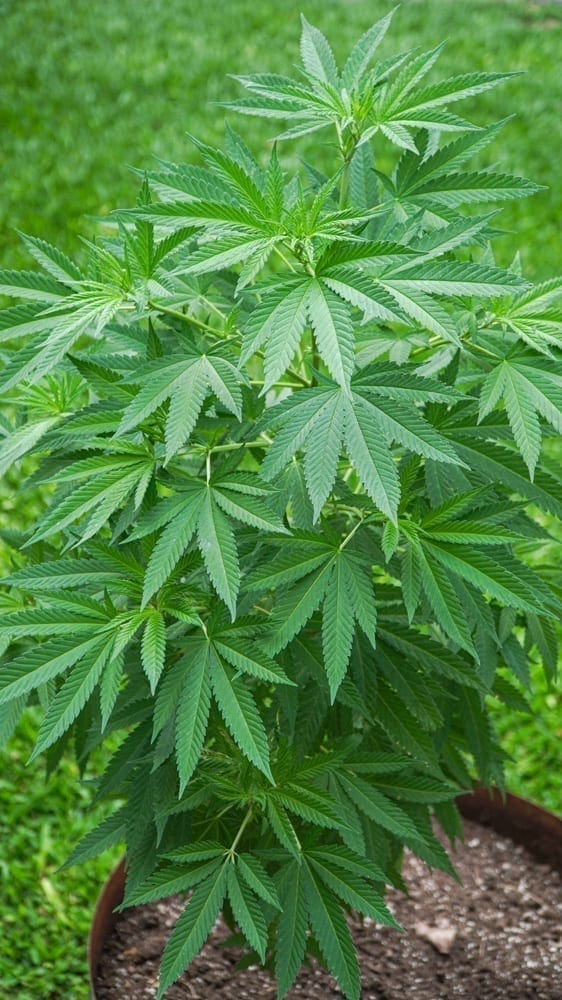

Nutrients during the flowering phase.
The flowering stage in marijuana plants is the menstruum when they abound their flowers or buds.
In this phase, in that location is high consumption of nutrients, mainly phosphorus, and potassium. To supply the plant with these elements, information technology is best to employ a fertilizer solution along the flowering stage. Different the vegetative stage, when the flowering process begins, the establish needs less nitrogen.
Fertilizers for the flowering stage contain a lower percentage of Northward (nitrogen) and a higher % of P (phosphorus) and Thou (potassium). For example NPK 5-9-9
Feeding the plants properly during the flowering phase will result in the salubrious development of the plant together with an abundant harvest, which is what every grower wants.
Biostimulants and supplements for the flowering phase increase and optimize the absorption of fertilizers, resulting in thicker, more compact flowers with a meliorate flavor. They as well promote the production of terpenes and cannabinoids and increment the natural resistance of plants confronting disease and stress.
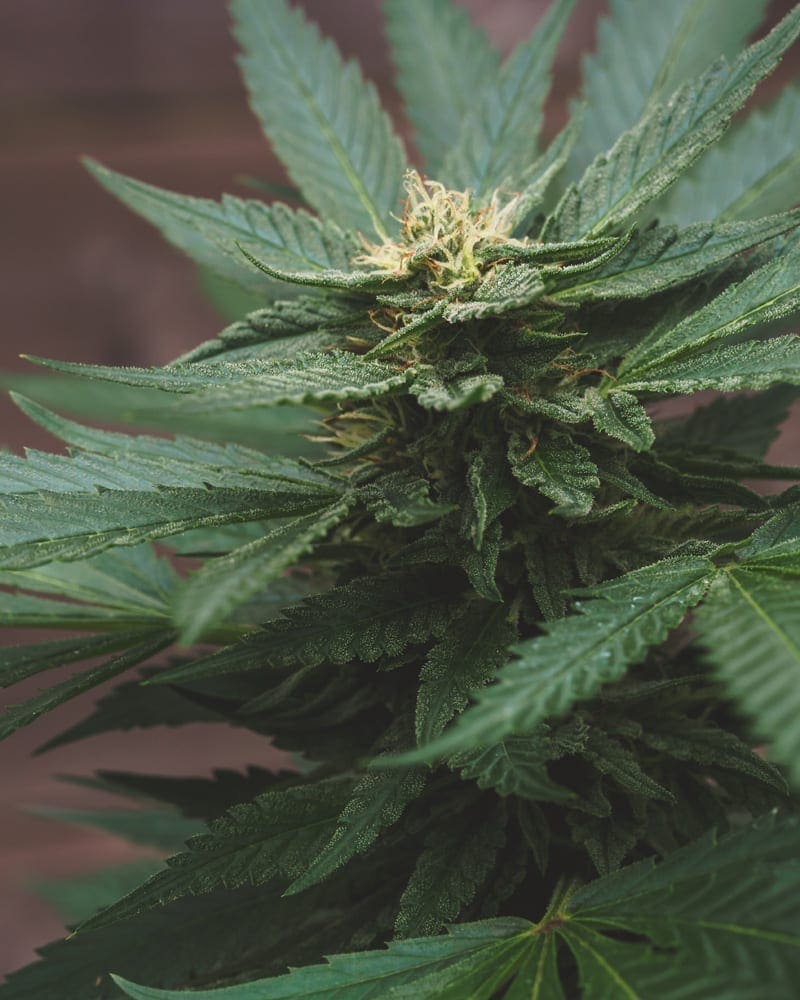
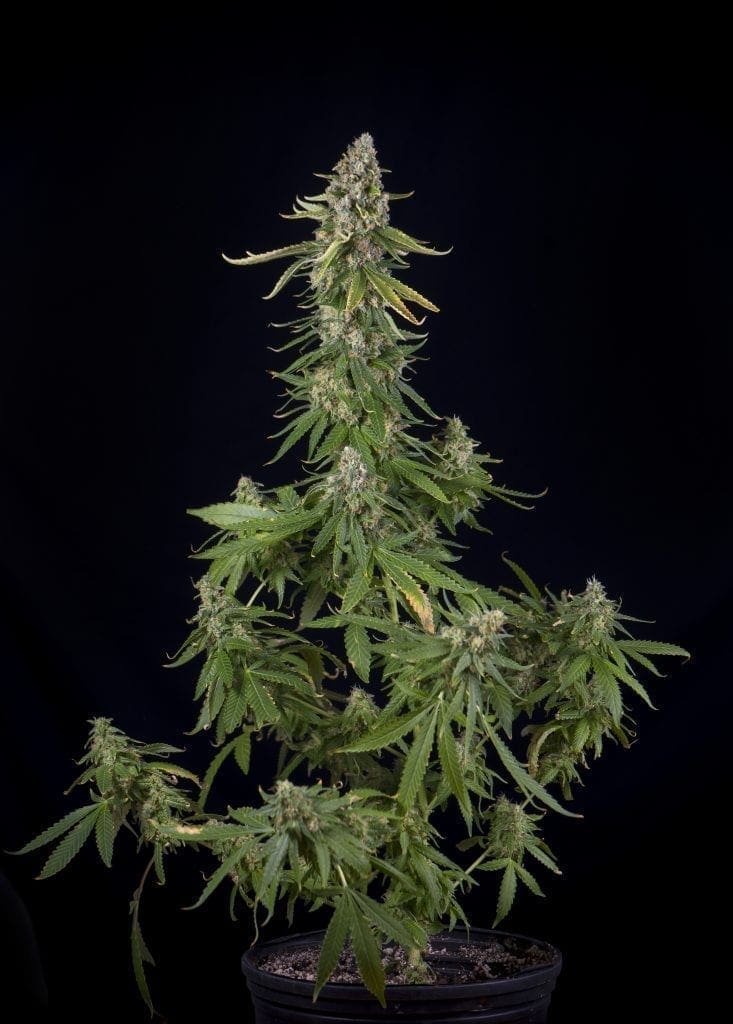
FAQs about Cannabis nutrients
When should I start feeding my plants with nutrients?
Yous can start giving your plants nutrients every bit soon as they have grown 2-3 sets of leaves. Some fertilizer brands start the feeding schedule after one week since germination, during the seedling stage, and this is perfectly fine. The dose will be significantly lower for a seedling so be conscientious to follow the instructions to avoid nutrient fire. Depending on the selected growing medium, nutrients are going to be needed sooner or earlier. Some soil mixes come with nutrients for the first 3-4 weeks, they are called "hot mixes". Avoid double fertilizing and risking burning by reading carefully what's on your mix and how to go on.
Should I use nutrients every time I water?
Some fertilizers are designed to be applied with every watering, other products are meant to be applied once a week with watering and the remainder of the week give them but h2o. Always follow the nutrients chart provided past your fertilizer brand to know exactly how oftentimes to fertilize. Keep track of your nutrient schedule to avoid nutrient deficiencies or excesses, which may severely harm your plants.
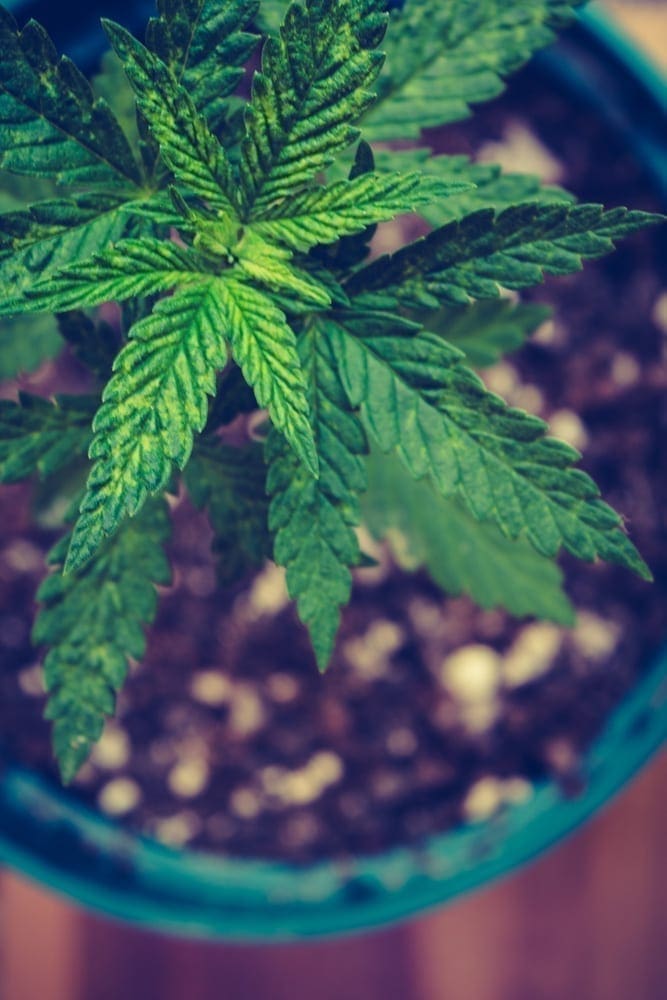
When to switch to flowering nutrients?
When y'all see the get-go signs of flowering phase and the found starts to develop pistils, the flowering process has started. You may apply blooming nutrients from week 4 or 5 of the vegetative stage if you lot are planning on switching to flowering soon.
If yous are planning on giving your plants a longer veg stag, you lot tin switch to bloom nutrients when the plant is big enough to fit the growing environment. Heed that plants stretch a chip more when the photoperiod changes, calculate their pinnacle or consider LST (Low-stress training). Remember to change the photoperiod (hours of lite) from eighteen/half dozen to 12/12 if growing regular seeds to trigger flowering.
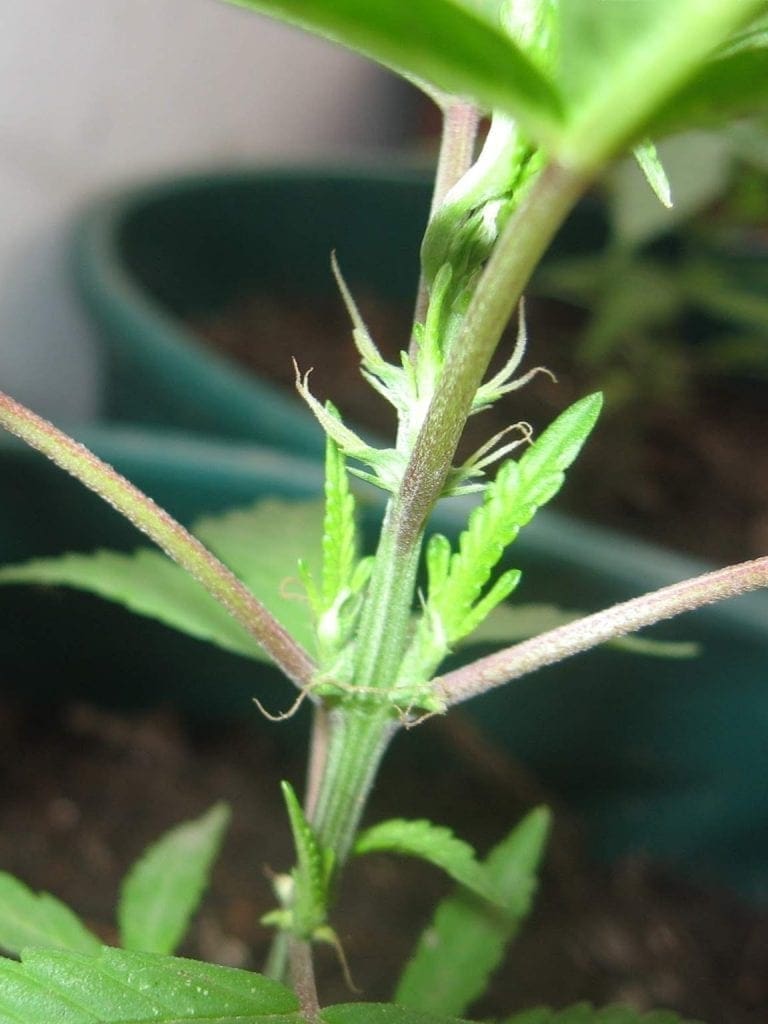
How often should I give my plants nutrients?
Some fertilizers are meant to exist applied with every watering, other brands propose applying but one time a week. Some supplements need to be applied once a month, or within some weeks. Read the instructions and prepare a calendar reminder at the Grow with Jane app to avoid forgetting or missing doses.
When should I finish giving my plant nutrients?
During the last week (or ii) of flowering, many growers stop feeding their Cannabis plants with nutrients and start watering with h2o only. Growers affluent their plants to avoid or minimize "chemical" flavor in the flowers when chemical fertilizers had been used. Near the harvesting date, pistils are going to expect brown and curled in and trichomes are going to look rather milky or amber/brown. Read our commodity to know when to harvest and how to flush your Cannabis plants.
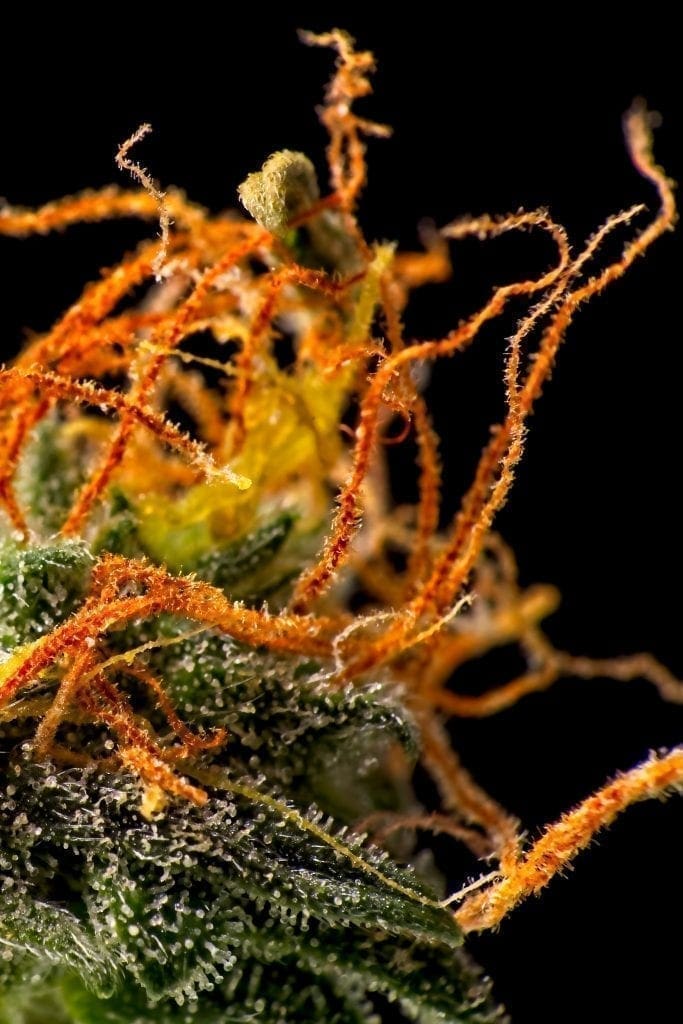
Source: https://growithjane.com/nutrients-cannabis-plants/